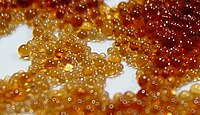
Photo from wikipedia
Abstract Nanocomposite materials as innovative environment and energy materials require superbly isolation performance to apply in practice. Here we report successful grafting of polyethylenimine (PEI) on multiwall carbon nanotubes (MWCNTs-PEI)… Click to show full abstract
Abstract Nanocomposite materials as innovative environment and energy materials require superbly isolation performance to apply in practice. Here we report successful grafting of polyethylenimine (PEI) on multiwall carbon nanotubes (MWCNTs-PEI) which was characterized using different techniques. The forier transform infrared (FTIR) and thermogravimetric analysis (TGA) analyses showed that PEI was successfully grafted on the oxidized surface of MWCNTs, which shows exceptionally high uptake capacity and stability towards U(VI) ions. The performance of MWCNTs-PEI adsorption characteristics was evaluated at different conditions including initial U(VI) concentration, adsorbent dosage, pH and contact time. The pH was found to have great effect on the adsoption process; the highest adsorption capacity obtained was found in pH range of 6.5–8.7. The experimental uptake of the fabricated MWCNTs-PEI nanocomposite ion-exchanger was found to be 947 mg U/g (nanocomposite), while the one calculated according to Langmuir model was found to be 997 mg/g with an (R2) of 0.978; the largest value reported to date for uranium extraction using MWCNTs based adsorbents from aqueous solutions. Additionally, four consecutive adsorption–desorption cycles suggesting that the synthesized MWCNTs-PEI had exceptional reversibility and stability for uranium isolation from aqueous solutions. This could be due to the synergetic effect of both carboxyl and amine groups attached to the surface of MWCNTs-PEI nanocomposite. The kinetics of the adsorption were best fitted to the pseudo 2nd order model. The MWCNTs-PEI prepared in this work could have great potential for U(VI) separation from aqueous solutions if turned into magnetic for easy separation.
Journal Title: Separation and Purification Technology
Year Published: 2020
Link to full text (if available)
Share on Social Media: Sign Up to like & get
recommendations!